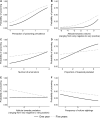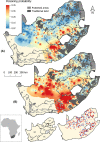Prevalence and drivers of poison use by South African commercial farmers and perceptions of alternative livestock protection measures
- PMID: 33454916
- PMCID: PMC8068749
- DOI: 10.1007/s13280-020-01461-2
Prevalence and drivers of poison use by South African commercial farmers and perceptions of alternative livestock protection measures
Abstract
The use of poison to eliminate predators is causing African vulture populations to collapse. To understand the prevalence and motivations of this practice we conducted an extensive survey with South African commercial farmers. Using a specialised questioning technique and ad hoc quantitative methods we found that an estimated 22% and 31% of farmers used poison over a 1-year and 5-year period, respectively. Poison use hotspots generally coincided with small stock farming areas. The strongest predictor of poison use was whether farmers believed the practice to be common amongst their peers. Our results suggest that farmers' attitudes to vultures are primarily positive, and farmers are less likely to use poisons if they frequently encounter vultures on their farm. Overall, our findings provide an understanding on poison use that provides leverage points to change farmers' behaviour and help avert the African vulture crisis and possible cascading ecosystem impacts.
Keywords: Human-wildlife conflict; Predator management; Vulture conservation; Wildlife crime.
Figures




Similar articles
-
Awareness of environmental legislation as a deterrent for wildlife crime: A case with Masaai pastoralists, poison use and the Kenya Wildlife Act.Ambio. 2022 Jul;51(7):1632-1642. doi: 10.1007/s13280-021-01695-8. Epub 2022 Jan 25. Ambio. 2022. PMID: 35079963 Free PMC article.
-
Small-livestock farmers' perceived effectiveness of predation control methods and the correlates of reported illegal poison use in the South African Karoo.Ambio. 2023 Oct;52(10):1635-1649. doi: 10.1007/s13280-023-01892-7. Epub 2023 Jun 30. Ambio. 2023. PMID: 37389757 Free PMC article.
-
The drivers and extent of poison use by Namibia's communal farmers: Implications for averting the African vulture crisis.Ambio. 2019 Aug;48(8):913-922. doi: 10.1007/s13280-018-1128-6. Epub 2018 Nov 27. Ambio. 2019. PMID: 30484066 Free PMC article.
-
Impact of climate change and variability on traditional farming systems: Farmers' perceptions from south-west, semi-arid Zimbabwe.Jamba. 2020 Sep 21;12(1):742. doi: 10.4102/jamba.v12i1.742. eCollection 2020. Jamba. 2020. PMID: 33101598 Free PMC article. Review.
-
The power of poison: pesticide poisoning of Africa's wildlife.Ann N Y Acad Sci. 2014 Aug;1322:1-20. doi: 10.1111/nyas.12405. Epub 2014 Apr 9. Ann N Y Acad Sci. 2014. PMID: 24716788 Review.
Cited by
-
Vulture poisoning in Sub-Saharan Africa and its implications for conservation planning: A systematic review.Heliyon. 2024 Jan 26;10(3):e25126. doi: 10.1016/j.heliyon.2024.e25126. eCollection 2024 Feb 15. Heliyon. 2024. PMID: 38333820 Free PMC article.
-
Awareness of environmental legislation as a deterrent for wildlife crime: A case with Masaai pastoralists, poison use and the Kenya Wildlife Act.Ambio. 2022 Jul;51(7):1632-1642. doi: 10.1007/s13280-021-01695-8. Epub 2022 Jan 25. Ambio. 2022. PMID: 35079963 Free PMC article.
-
The value of transhumance for biodiversity conservation: Vulture foraging in relation to livestock movements.Ambio. 2022 May;51(5):1330-1342. doi: 10.1007/s13280-021-01668-x. Epub 2021 Dec 7. Ambio. 2022. PMID: 34874529 Free PMC article.
-
Small-livestock farmers' perceived effectiveness of predation control methods and the correlates of reported illegal poison use in the South African Karoo.Ambio. 2023 Oct;52(10):1635-1649. doi: 10.1007/s13280-023-01892-7. Epub 2023 Jun 30. Ambio. 2023. PMID: 37389757 Free PMC article.
References
-
- Abrahamse W, Steg L, Vlek C, Rothengatter T. A review of intervention studies aimed at household energy conservation. Journal of Environmental Psychology. 2005;25:273–291. doi: 10.1016/j.jenvp.2005.08.002. - DOI
-
- Badenhorst, C.G. 2014. The economic cost of large stock predation in the North West Province of South Africa. MSc Thesis: University of the Free State.
-
- Blair G, Imai K. Statistical analysis of list experiments. Political Analysis. 2012;20:47–77. doi: 10.1093/pan/mpr048. - DOI
-
- Blair G, Chou W, Imai K. List experiments with measurement error. Political Analysis. 2019;27:455–480. doi: 10.1017/pan.2018.56. - DOI
-
- Brink CW, Santangeli A, Amar A, Wolter K, Tate G, Krüger S, Tucker AS, Thomson RL. Perceptions of vulture supplementary feeding site managers and potential hidden risks to avian scavengers. Conservation Science and Practice. 2020;2:e237. doi: 10.1111/csp2.237. - DOI
MeSH terms
Substances
Grants and funding
LinkOut - more resources
Full Text Sources
Other Literature Sources

